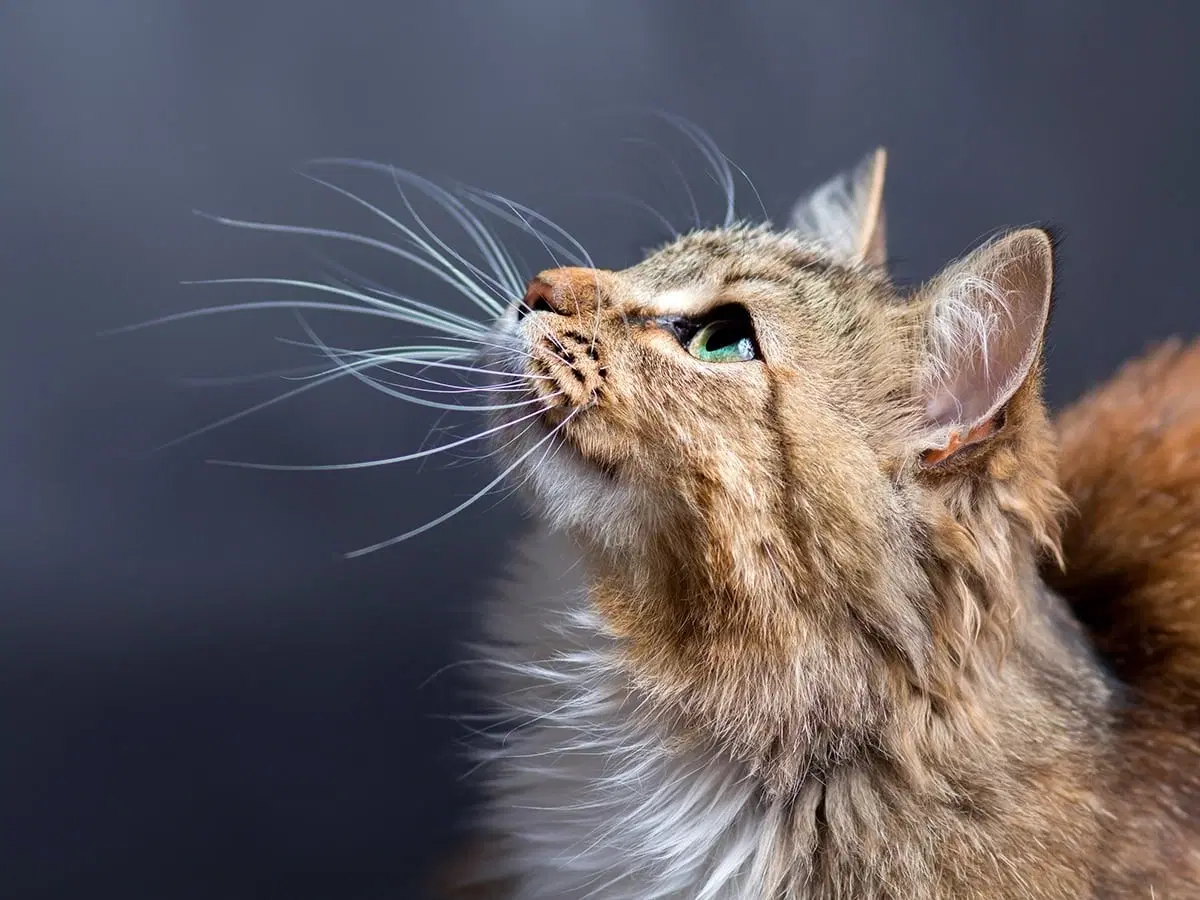If you’re a cat owner or a cat lover, you know that their beautiful, long, wispy whiskers are an especially notable feature! It can be astonishing how long some cat’s whiskers are, giving them a rather distinguished look.
These delicate little hairs on their face are not just a part of their look but also serve essential functions. Like we use sight, smell, touch, and hearing – whiskers are an extension of your cat’s senses! Whiskers are vital to your cat’s awareness and contribute largely to helping them understand the world around them.
Vets and experts agree that whiskers should never be trimmed or cut. Clipping your cat’s whiskers would be like taking away part of their vision or sense of smell. Doing so would be highly disorienting for your feline family member.
Let’s talk about what your cat’s whiskers are doing for them, why they’re essential, and what happens when they are clipped.
What do whiskers do?
Every animal’s body has built-in features that have evolved over the centuries to help them navigate the world, stay safe, and know its surroundings. Certain species have developed night vision, some have hearing that ranges hundreds of miles, and some even have camouflaging capabilities on their skin! Cats are no different and have multiple crucial physical features for survival.
Like humans, cats constantly take in the world around them using their senses. Always seeing, smelling, hearing, and feeling to gain their bearings. But unlike humans, your cat also uses hair to sense its surroundings. And although whiskers might just look like a longer protruding version of the rest of the hair on your cat’s body, they are very different!
You may think that whiskers are only on your cat’s face as that’s the most obvious spot, but whiskers can be found above their eyes and upper lip, on their chin, legs, and around the ears. Whiskers come from regular hair follicles but are thicker and coarser than your cat’s coat hair. The root of the whisker follicle goes three times deeper than regular hair roots. Whisker roots have a high concentration of blood vessels and sensitive nerves. Because of these highly responsive nerves, some say whiskers have the same sensitivity as human fingertips.
Like fingers, the nerves in whiskers send signals to the brain. They receive and interpret touch, and cats use them to situate themselves. Whiskers are so sensitive that they react not only to touch but even a shift in air moving. These sensory cells constantly send messages to the brain, allowing cats to be highly aware of whatever is happening around them.
Now that we’ve discussed how whiskers work, let’s look at their primary functions.
Spatial Awareness – The length of your cat’s whiskers is not only a cute look but actually enables them to gauge space. Having such long and sensitive hairs sticking out of their face can help them see if they will fit through a crack or get stuck in a space. After all, cat owners know that you might find your cat in the most unexpected places around your home! This is because they pay extra attention to their whiskers when entering a nook or cranny to gauge if they will fit.
Communication – Like you might use your facial expressions to express what you’re feeling and thinking, cats are no different! Whiskers serve as a way for your cat to portray what they’re feeling. Pulling their whiskers close to their face might be their way of showing they are nervous or feeling on edge. On the other hand, if their whiskers are moving around and extra active, they might be investigating what’s around them! A relaxed whisker position is common if your cat is resting or relaxing.
Helping Them See – Cats use all their senses, but their sense of smell and hearing is more robust than their sight. Your cat probably doesn’t have 20/20 vision, but they can see things at a distance. As objects get closer, it is harder for your cat’s eyes to focus. This is where whiskers come in to help them see better. Even though their whiskers don’t have visual capabilities, their high sensitivity is just as beneficial! Acting as a radar, cats can sense air bouncing back at them from the air they are pushing into an area. This helps them know when something is right in front of them or a foot away. When exploring at night, whiskers are employed to fill in the dark spots in their vision. Informing them where objects they might bump into are, where their toys may be, or their bed.
Balance – Everybody talks about cats’ remarkable ability to always land on their feet, but many may not know that whiskers play a significant role in this! Bodily position and awareness are largely informed by the receptors on a cat’s whiskers. At the end of each whisker, there are special receptors called proprioceptors that help cats have an awareness of their limbs.
Protecting Their Face and Body – Like eyelashes, whiskers safeguard cat’s sensitive facial features and feet. If debris or dust comes near their face, whiskers let cats know that it’s there but also serve as a barrier to the eyes and nose. If cats are about to walk into a prickly bush, their whiskers will make contact first and tell them to avoid it.
What happens if whiskers get clipped?
Knowing all the ways whiskers serve your kitty, you might understand why it is essential to keep them safe. Just as their whiskers protect them, they also need protection. Not only does a trimmed whisker disorient your cat, it is also robbing them of one of their senses. This is why whiskers should never be cut.
Thinking about the human fingertip analogy, going without that sensory awareness can make going about daily life for your cat difficult. Not only is it uncomfortable, but it can put them at risk of injury as whiskers are a warning sign against danger. In fact, about 40% of cats’ sensory brain input comes from where their whiskers are located. Without this spatial awareness, it can be hard for them to navigate safely.
That said, whiskers sometimes shed naturally and can fall out on their own. Don’t worry if you somehow notice your kitty is missing one! But if they are shedding more than 1-2 whiskers, you might want to ask your vet if something else is wrong.
Whiskers are vital, but sometimes they break off or need to be cut for medical reasons. If this is the case, the whiskers are similar to normal hair in that the follicle will most likely grow the hair back.
Keeping your cat’s whiskers safe and intact is crucial to their health, well-being, and senses!

Mostly a tech person, always a pet person. I am dedicated to improving the lives of pets and their humans with technology. Off-duty, I enjoy writing about the misbehaving of computer programs and my two Aussiedoodles, Calvin and Hobbes.
How Often Should Cat’s Whiskers Be Trimmed? | vethelpdirect.com
Why Do Cats Have Whiskers? | VCA Animal Hospitals












